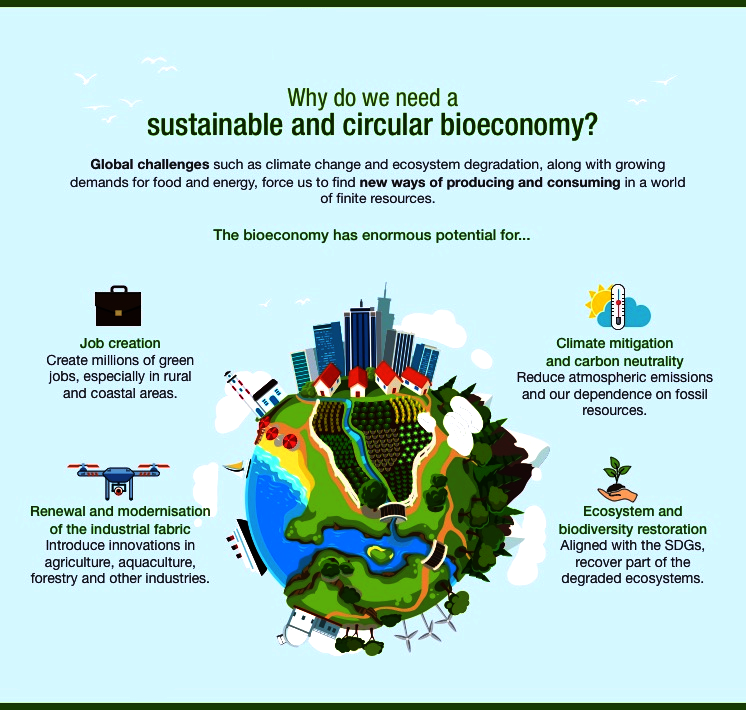Economy
Bioeconomy
- 22 Jul 2022
- 6 min read
For Prelims: Bioeconomy, India’s Bioeconomy Report 2022
For Mainns: Bioeconomy and its advantages
Why in News?
Recently, Biotechnology Industry Research Assistance Council (BIRAC) released India’s Bioeconomy Report 2022.
- During the release, the government launched a special Biotech Ignition Grant call for North East Region (BIG-NER) and announced financial support of up to Rs 50 Lakhs each to 25 startups and entrepreneurs from North East Region to develop biotech solutions.
- BIRAC is a not-for-profit Section 8, Schedule B, Public Sector Enterprise, set up by Department of Biotechnology (DBT).
What are the Key Highlights of the Report?
- India’s bioeconomy is likely to touch USD 150 billion by 2025 and over USD 300 billion by 2030.
- The country’s bioeconomy has reached over USD 80 billion in 2021, registering a 14.1 percent growth over USD 70.2 billion in 2020.
- On average, at least three biotech startups were incorporated every day in 2021 (a total of 1,128 biotech startups set up in 2021) and the industry crossed USD 1 billion in research and development spending.
- India has the second highest number of USFDA-approved manufacturing plants outside the US.
- USFDA: US Food and Drug Administration
- Vaccination:
- India administered nearly 4 million doses of Covid-19 vaccines per day (a total of 1.45 billion doses given in 2021).
- Covid-19:
- The country conducted 1.3 million Covid-19 tests each day in 2021 (a total of 506.7 million tests).
What is Bioeconomics?
- About:
- As per, the United Nations Food and Agriculture Organization (FAO), Bio-economics could be defined as the production, use, and conservation of biological resources, including related knowledge, science, technology, and innovation to provide information, products, processes, and services to all economic sectors with the aim of moving towards a sustainable economy.
- Historical Background:
- The term bioeconomy became popular in the first decade of the 21st century following its adoption by the European Union (EU) and the Organisation for Economic Co-operation and Development (OECD) as a framework for promoting the use of biotechnology to develop new products and markets.
- Examples:
- Food systems occupy the largest niche in the bioeconomy. To these systems, which include
- Sustainable agriculture,
- Sustainable Fishing,
- Forestry and aquaculture,
- Food and feed manufacturing,
- Bio-Based Products:
- Bioplastics,
- Biodegradable clothing.
- Food systems occupy the largest niche in the bioeconomy. To these systems, which include
What is Circular Bioeconomy?
- Bioeconomy aims to drive both sustainable development and circularity. In particular, the principles of the circular economy — reuse, repair and recycle — are a fundamental part of the bioeconomy.
- The total amount of waste and its impact is reduced through reuse, repair, and recycling. It also saves energy and minimizes air and water pollution, thus helping to prevent damage to the environment, climate and biodiversity.
How is India moving Forward in Bioeconomy?
- There are various sectors which are contributing to the growth of India’s Bioeconomy sector like,
- Bio-Industry, as this sector has got fillip from the Prime Ministers vision of Atmanirbhar Bharat and India becoming “energy independent” by 2047.
- Further, the Indian Government has approved the amendments to the National Policy on Biofuels and took decisions to increase biofuel production and advance the introduction of ethanol blended petrol with up to 20% blend from April 2023.
- Another sector like Bio-Agri, which comprises of Bt Cotton, pesticides, marine biotech, and animal biotech has the potential to nearly double its Bioeconomy contribution from USD10.5 billion to USD 20 billion in 2025.
- Before the pandemic, India was the second largest vaccine exporter by volume according to various research studies.
- Bio-Industry, as this sector has got fillip from the Prime Ministers vision of Atmanirbhar Bharat and India becoming “energy independent” by 2047.
What are the Indian Initiatives related to Bioeconomy?
- For Biopharma:
- National Biopharma Mission, ‘Innovate India’ 2017, a Department of Biotechnology (DBT) programme worth US$ 250 million, aims to bring together industry and academia in order to promote entrepreneurship and indigenous manufacturing in biopharma.
- For Promoting Startups:
- 35 Bio incubators have been set up across India with world-class facilities.
- The first International Incubator- Clean Energy International Incubator has been set up under Mission Innovation by DBT & BIRAC.
- Startups from 23 participating EU countries can potentially come & incubate in India and likewise, startups from this incubator can go to the partnering countries facilitating access to global opportunities. The department is supporting 4 Bio-clusters (NCR, Kalyani, Bangalore, and Pune).
- National Mission on Bioeconomy: Amid attempts to boost rural economy by using bio-resources, a 'National Mission on Bioeconomy' was launched by the Institute of Bio-resources and Sustainable Development under the Science and Technology Ministry, in 2016.





